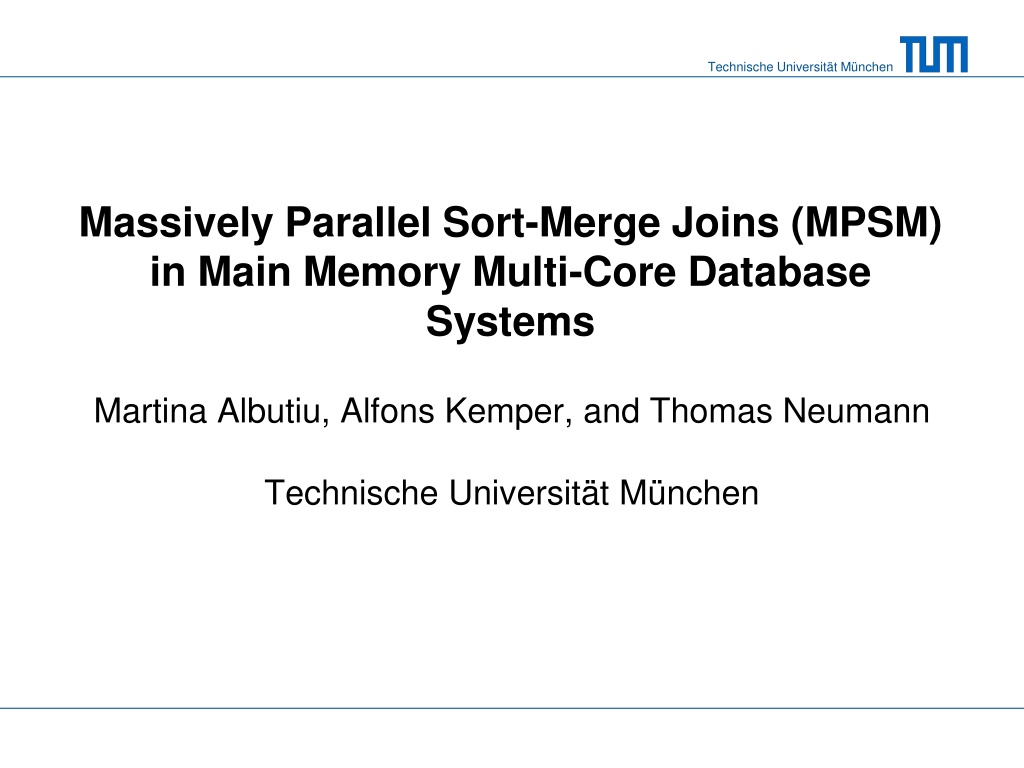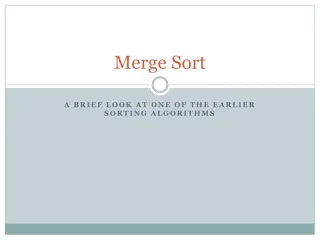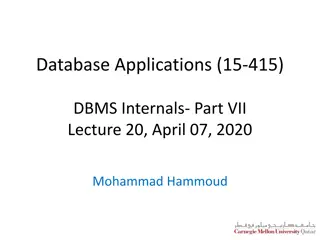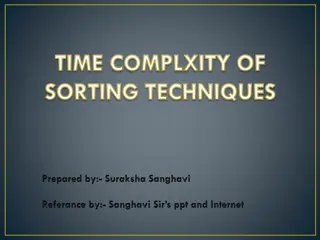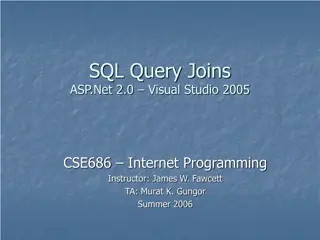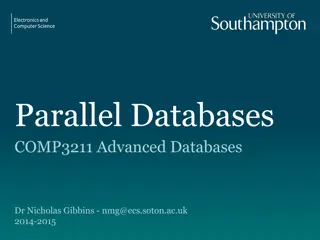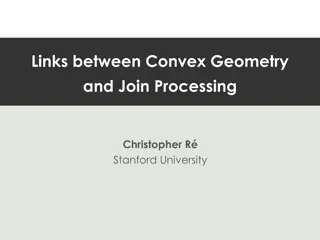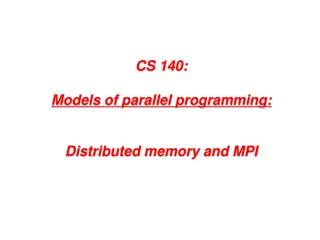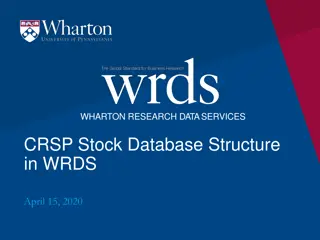Massively Parallel Sort-Merge Joins in Main Memory Multi-Core Database Systems
Explore the hardware trends and techniques used at Technische Universität München for massively parallel sort-merge joins in main memory multi-core database systems. The research focuses on exploiting fast main memory access, parallelizing algorithms, and optimizing performance in a NUMA environment.
Uploaded on Sep 11, 2024 | 0 Views
Download Presentation

Please find below an Image/Link to download the presentation.
The content on the website is provided AS IS for your information and personal use only. It may not be sold, licensed, or shared on other websites without obtaining consent from the author. Download presentation by click this link. If you encounter any issues during the download, it is possible that the publisher has removed the file from their server.
E N D
Presentation Transcript
Technische Universitt Mnchen Massively Parallel Sort-Merge Joins (MPSM) in Main Memory Multi-Core Database Systems Martina Albutiu, Alfons Kemper, and Thomas Neumann Technische Universit t M nchen
Technische Universitt Mnchen Hardware trends Huge main memory Massive processing parallelism Non-uniform Memory Access (NUMA) Our server: 4 CPUs 32 cores 1 TB RAM 4 NUMA partitions CPU 0 2
Technische Universitt Mnchen Main memory database systems VoltDB, Hana, MonetDB HyPer: real-time business intelligence queries on transactional data* * http://www-db.in.tum.de/research/projects/HyPer/ 3
Technische Universitt Mnchen How to exploit these hardware trends? Parallelize algorithms Exploit fast main memory access Kim, Sedlar, Chhugani: Sort vs. Hash Revisited: Fast Join Implementation on Modern Multi-Core CPUs. VLDB 09 Blanas, Li, Patel: Design and Evaluation of Main Memory Hash Join Algorithms for Multi-core CPUs. SIGMOD 11 AND be aware of fast local vs. slow remote NUMA access 4
Technische Universitt Mnchen Ignoring NUMA NUMA partition 1 NUMA partition 3 core 1 core 5 hashable core 2 core 6 core 3 core 7 core 4 core 8 NUMA partition 2 NUMA partition 4 5
Technische Universitt Mnchen How much difference does NUMA make? 100% 22756 ms 417344 ms 1000 ms 837 ms scaled execution time 12946 ms 7440 ms merge join (sequential read) sort partitioning 6
Technische Universitt Mnchen The three NUMA commandments C2 C3 C1 Thou shalt read thy neighbor s memory only sequentially -- let the prefetcher hide the remote access latency. Thou shalt not wait for thy neighbors -- don t use fine- grained latching or locking and avoid synchronization points of parallel threads. Thou shalt not write thy neighbor s memory randomly -- chunk the data, redistribute, and then sort/work on your data locally. 7
Technische Universitt Mnchen Basic idea of MPSM chunk R R R chunks S chunks S chunk S 8
Technische Universitt Mnchen Basic idea of MPSM C1: Work locally: sort C3: Work independently: sort and merge join C2: Access neighbor s data only sequentially chunk R sort R chunks locally R chunks merge join chunks MJ MJ MJ MJ S chunks sort S chunks locally chunk S 9
Technische Universitt Mnchen Range partitioning of private input R To constrain merge join work To provide scalability in the number of parallel workers 10
Technische Universitt Mnchen Range partitioning of private input R To constrain merge join work To provide scalability in the number of parallel workers R chunks range partition R range partitioned R chunks 11
Technische Universitt Mnchen Range partitioning of private input R To constrain merge join work To provide scalability in the number of parallel workers S is implicitly partitioned range partitioned R chunks sort R chunks S chunks sort S chunks 12
Technische Universitt Mnchen Range partitioning of private input R To constrain merge join work To provide scalability in the number of parallel workers S is implicitly partitioned range partitioned R chunks sort R chunks merge join only relevant parts MJ MJ MJ MJ S chunks sort S chunks 13
Technische Universitt Mnchen Range partitioning of private input Time efficient branch-free comparison-free synchronization-free and Space efficient densely packed in-place by using radix-clustering and precomputed target partitions to scatter data to 14
Technische Universitt Mnchen Range partitioning of private input prefix sum of worker W1 0 0 1 histogram of worker W1 4 3 19=10011 19 19 chunk of worker W1 9 7 3 21 1 17 17 W1 <16 16 7 = 00111 21 2 17 = 10001 W2 2=00010 histogram of worker W2 3 4 prefix sum of worker W2 4 3 2 23 4 31 8 20 26 26 19 chunk of worker W2 W1 23 5 <16 16 31 W2 20 15
Technische Universitt Mnchen Range partitioning of private input prefix sum of worker W1 0 0 1 histogram of worker W1 4 3 19=10011 19 9 chunk of worker W1 9 7 3 21 1 17 7 3 1 2 W1 <16 16 7 = 00111 17 = 10001 W2 4 8 2=00010 histogram of worker W2 3 4 prefix sum of worker W2 4 3 2 23 4 31 8 20 26 19 chunk of worker W2 W1 21 5 <16 16 17 23 31 20 26 W2 16
Technische Universitt Mnchen Real C hacker at work
Technische Universitt Mnchen Skew resilience of MPSM Location skew is implicitly handled Distribution skew: Dynamically computed partition bounds Determined based on the global data distributions of R and S Cost balancing for sorting R and joining R and S 18
Technische Universitt Mnchen Skew resilience 1. Global S data distribution Local equi-height histograms (for free) Combined to CDF CDF 1 2 12 17 25 33 42 78 90 S2 # tuples 7 10 15 22 31 66 81 S1 16 13 keyvalue 50 19
Technische Universitt Mnchen Skew resilience 2. Global R data distribution Local equi-width histograms as before More fine-grained histograms 2 13 histogram 3 2 1 1 2 = 00010 13 4 31 8 8 20 <8 [8,16) [16,24) 24 31 8 = 01000 20 6 R1 20
Technische Universitt Mnchen Skew resilience 3. Compute splitters so that overall workloads are balanced*: greedily combine buckets, thereby balancing the costs of each thread for sorting R and joining R and S are balanced CDF # tuples histogram 3 2 1 1 2 4 6 + = 13 31 8 20 key value * Ross and Cieslewicz: Optimal Splitters for Database Partitioning with Size Bounds. ICDT 09 21
Technische Universitt Mnchen Performance evaluation MPSM performance in a nutshell: 160 mio tuples joined per second 27 bio tuples joined in less than 3 minutes scales linearly with the number of cores Platform HyPer1: Linux server 1 TB RAM 4 CPUs with 8 physical cores each Benchmark: Join tables R and S with schema {[joinkey: 64bit, payload: 64bit]} Dataset sizes ranging from 50GB to 400GB 22
Technische Universitt Mnchen Execution time comparison MPSM, Vectorwise (VW), and Blanas hash join* 32 workers |R| = 1600 mio (25 GB), varying size of S * S. Blanas, Y. Li, and J. M. Patel: Design and Evaluation of Main Memory Hash Join Algorithms for Multi-core CPUs. SIGMOD 2011 23
Technische Universitt Mnchen Scalability in the number of cores MPSM and Vectorwise (VW) |R| = 1600 mio (25 GB), |S|=4*|R| 24
Technische Universitt Mnchen Location skew Location skew in R has no effect because of repartitioning Location skew in S: in the extreme case all join partners of Ri are found in only one Sj (either local or remote) 25
Technische Universitt Mnchen Distribution skew: anti-correlated data without balanced partitioning with balanced partitioning 26
Technische Universitt Mnchen Distribution skew : anti-correlated data 27
Technische Universitt Mnchen Conclusions MPSM is a sort-based parallel join algorithm MPSM is NUMA-aware & NUMA-oblivious MPSM is space efficient (works in-place) MPSM scales linearly in the number of cores MPSM is skew resilient MPSM outperforms Vectorwise (4X) and Blanas et al s hash join (18X) MPSM is adaptable for disk-based processing See details in paper 28
Technische Universitt Mnchen Massively Parallel Sort-Merge Joins (MPSM) in Main Memory Multi-Core Database Systems Martina Albutiu, Alfons Kemper, and Thomas Neumann Technische Universit t M nchen THANK YOU FOR YOUR ATTENTION!
